
by Ria Olivier | Jun 21, 2021 | Overwintering Team, SANAP

 MidWinter greetings to all South Africans involved in the South African National Antarctic Programme. Especially Happy MidWinter to current and past overwintering team members. Our best wishes to all other Antarctic countries. South Africa’s Overwintering Teams send their greetings from down South.
MidWinter greetings to all South Africans involved in the South African National Antarctic Programme. Especially Happy MidWinter to current and past overwintering team members. Our best wishes to all other Antarctic countries. South Africa’s Overwintering Teams send their greetings from down South.
 SANAE 60 from SANAE IV on ANtarctica
SANAE 60 from SANAE IV on ANtarctica
 MARION 78 at Marion Island
MARION 78 at Marion Island
 GOUGH 66 at Gough Island
GOUGH 66 at Gough Island
The SANAP community wishes all countries and their teams based in the Antarctic region a Happy Midwinter.

by Ria Olivier | Jun 19, 2021 | Uncategorised

World Albatross Day 2021 is finally here! In May 2019, The Agreement of Conservation of Albatrosses and Petrels (ACAP) Advisory Committee stated that a conservation crisis is faced by 31 listed species of seabirds. Thousands of petrels, shearwaters and albatrosses are dying every year due to the impact of the fishing industry. The need to increase global awareness was instituted by the ACAP in 2020 and thus World Albatross Day is now celebrated every year on the 19th June.
The theme for World Albatross Day 2021 is “Ensuring Albatross-friendly Fisheries”. Due to the large number of seabirds killed as a result of fisheries industry was a main catalyst for the establishment of ACAP and the need to continue and strengthen conservation efforts on a global scale.
 Fun and amazing facts about the albatross is that there are 22 species in the world and they can fly 16,000 km without returning to land! These seabirds are incredible and in support of World Albatross Day, ACAP have created posters and artwork of the 22 albatross species which can be downloaded at (www.acap.aq). The hope is that through the use of these resources, awareness and appreciation for the albatross will be steered amongst members of the public, organisations, schools and Trusts. More albatross images can be viewed on the Antarctic Legacy of South Africa digital repository, which have been collected over the years from Overwintering team members and Takeover Personnel.
Fun and amazing facts about the albatross is that there are 22 species in the world and they can fly 16,000 km without returning to land! These seabirds are incredible and in support of World Albatross Day, ACAP have created posters and artwork of the 22 albatross species which can be downloaded at (www.acap.aq). The hope is that through the use of these resources, awareness and appreciation for the albatross will be steered amongst members of the public, organisations, schools and Trusts. More albatross images can be viewed on the Antarctic Legacy of South Africa digital repository, which have been collected over the years from Overwintering team members and Takeover Personnel.
 Furthermore, South African National Antarctic Programme (SANAP) in conjunction with Birdlife – South Africa and Percy Fitzpatrick Institute of African Ornithology (UCT) has played an integral role in seabird preservation through ongoing conservation programmes and research projects. Ornithologists form part of the Overwintering teams stationed at South Africa’s research bases namely, Marion Island and Gough Island. Their aim is to conduct conservation research on the seabird population and how best to combat the threats impacting the seabird population. The Gough Island Restoration Programme, was established to eradicate the invasive mice species (introduced by sailors during the 19th century) which exploit available food resources and cause bodily harm to albatross chicks and adults. The Mouse-Free Marion programme objectives are as follows: – as seen on Gough Island Restoration Programme webpage.
Furthermore, South African National Antarctic Programme (SANAP) in conjunction with Birdlife – South Africa and Percy Fitzpatrick Institute of African Ornithology (UCT) has played an integral role in seabird preservation through ongoing conservation programmes and research projects. Ornithologists form part of the Overwintering teams stationed at South Africa’s research bases namely, Marion Island and Gough Island. Their aim is to conduct conservation research on the seabird population and how best to combat the threats impacting the seabird population. The Gough Island Restoration Programme, was established to eradicate the invasive mice species (introduced by sailors during the 19th century) which exploit available food resources and cause bodily harm to albatross chicks and adults. The Mouse-Free Marion programme objectives are as follows: – as seen on Gough Island Restoration Programme webpage.
- To prevent the extinction of the Critically Endangered Tristan albatross, the Endangered MacGillivray’s prion, and several other small seabird species that are affected by invasive non-native mice.
- To restore the fortunes of Gough Island’s seabirds and ensure the island remains one of the world’s most important seabird nesting sites, worthy of its World Heritage Site status.
- To support Tristan da Cunha in ensuring the long-term future of this special island and its unique wildlife.

Tristan Albatross

Waved Albatross
Two critically endangered albatross species (namely: Tristan and Waved albatross) from Gough Island and the Galapagos islands have been chosen to serve as the “feature species” to draw attention to the continuing threats all the world’s species of albatrosses face. It is essential to protect and conserve seabirds as they form an integral part of the oceanic ecosystem. Let’s celebrate World Albatross Day, by raising awareness, educating the public about the ongoing issues and show our support of research endeavours such as the Mouse-Free Marion project: https://blogs.sun.ac.za/antarcticlegacy/2021/04/16/do-you-want-to-be-part-of-the-legacy-to-make-marion-island-mouse-free/
Cover photo: Tahlia Henry

by Ria Olivier | Jun 16, 2021 | International Days, SANAP, SANAP Student
 Today 16 June 2021 on South African Youth Day we congratulate the students within SANAP community that have graduated during the past year.
Today 16 June 2021 on South African Youth Day we congratulate the students within SANAP community that have graduated during the past year.
“The lack of a real graduation ceremony made it less sensational, and we risk to forget that we should celebrate our students’ achievements” – Marcello Vichi

 Left: Liezel Rudolph received her PhD certificate (all the way from Fort Hare University) during takeover to Marion Island on the S.A. Agulhas II with supervisors Werner Nel and David Hedding. Right: Brendon Nickerson with his supervisor Annie Bekker at PhD graduation ceremony at Stellenbosch University wearing masks.
Left: Liezel Rudolph received her PhD certificate (all the way from Fort Hare University) during takeover to Marion Island on the S.A. Agulhas II with supervisors Werner Nel and David Hedding. Right: Brendon Nickerson with his supervisor Annie Bekker at PhD graduation ceremony at Stellenbosch University wearing masks.
| Graduate | Degree | Institution | Supervisor |
| Elizabeth Rudolph | PhD | FH - Geography and Environmental Sciences | Werner Nel, David Hedding |
| Towards an improved understanding of the Southern Ocean’s biological pump: Phytoplankton group-specific contributions to nitrogen and carbon cycling across the Subantarctic Indian Ocean |
| Mapuka Nomsa | MSc | FH - Geography and Environmental Sciences | Werner Nel |
| The characteristics and trends of rainfall on sub-Antarctic Marion Island and associated air circulation patterns |
| Tegan Carpenter-Kling | PhD | NMU - Zoology (MAPRU) | Pierre Pistorius |
| Foraging in a dynamic environment: Movement and stable isotope ecology of marine top predators breeding at the Prince Edward Archipelago’ |
| Heather Forrer | MSc | UCT - Oceanography (Fawcett Lab) | Sarah Fawcett |
| Towards an improved understanding of the Southern Ocean’s biological pump: Phytoplankton group-specific contributions to nitrogen and carbon cycling across the Subantarctic Indian Ocean |
| Mark Hague | PhD | UCT - Oceanography (MARIS) | Marcello Vichi |
| The implications of ice - ocean - atmosphere interactions for phytoplankton phenology in the Southern Ocean |
| Ashleigh Womack | MSc | UCT - Oceanography (MARIS) | Marcello Vichi |
| Atmospheric drivers of ice drift in the Antarctic marginal ice zone |
| Jamie Jacobson | MSc | UCT - Oceanography (MARIS) | Marcello Vichi, A Mishra,R Verrinder |
| Development of Antarctic ice-tethered buoys |
| Ayanda Mpalweni | MSc | UCT - Oceanography (MARIS) | Marcello Vichi, Sarah Nicholson |
| Characterising the seasonal response of the mixed layer and the transitional layer to the passage of storms in the Sub-Antarctic Zone |
| Siobhan Johnson | MSc | UCT - Oceanography (MARIS) | Tokoloho Rampai, Marcello Vichi |
| Evaluation of the changes in the crystal structure of Antarctic sea ice from the marginal ice zone during winter and spring |
| Alexis Osborne | MSc | UCT - Zoology (Fitzpatrick Institute) | Peter Ryan |
| Understanding moult patterns in albatrosses and petrels breeding on Marion and Gough Islands |
| Mancha Mabaso | MSc | UP - Natural & Agricultural Sciences (GRI) | Thulane Makhalanyane |
| Elucidating the effects of physicochemical variables on the structure, composition and functionality of microbiomes in the Prince Edward Islands |
| Sunette Vos | MSc | UP - Natural & Agricultural Sciences (GRI) | Thulane Makhalanyane, Suzanne Fietz |
| Viral-host dynamics in marine environments |
| Liezl Pretorius | MSc | UP - Zoology and Entomology | Greg Hofmeyr, Marthán Bester, Maëlle Connan |
| Effect of sex and ontogeny on the trophic ecology of Southern Ocean fur seals |
| Kyle Lloyd | PhD | UP - Zoology (MIMMP) | Nico de Bruyn, Chris Oosthuizen |
| Individual variation in male southern elephant seal demography |
| Rowan Jordaan | PhD | UP - Zoology (MIMMP) | Nico de Bruyn, Chris Oosthuizen, Ryan Reisinger |
| Demographics of Marion Island killer whales |
| Nico L ü bcker | PhD | UP - Zoology (MIMMP) | Nico de Bruyn, RP Millar |
| Trophic influences, nutritional status, endocrine response on amino acid metabolism and reproduction of mammals |
| Yinhla Shilomule | MSc | UP - Zoology (MIMMP) | Nico de Bruyn, Ar Hoezel, Chris Oosthuizen |
| Hybridization and genetic variation of fur seals at Marion Island |
| Itai Mukutyu | MSc | UP - Zoology (MIMMP) | Nico de Bruyn, Mia Wege |
| Isotopic niche partitioning in sympatric fur seals from Marion Island |
| Caitlin van der Merwe | BSc Honns | UP - Zoology (MIMMP) | Nico de Bruyn, Cheryl Tosh |
| Oceanographic indicators of southern elephant foraging area avoidance |
| Leandri de Kock | BSc Honns | UP - Zoology (MIMMP) | Nico de Bruyn, Chris Oosthuizen |
| Phenology of southern elephant seal moult |
| Brendon Nickerson | PhD | US - Engineering (SVRG) | Annie Bekker |
| Inverse models for ice induced propeller moments on a polar vessel |
| Gerhard Durandt | M.Eng | US - Engineering (SVRG) | Annie Bekker |
| Data driven Regression Models for Voyage Cost Optimization Based on the Operating Conditions of the SA Agulhas II |
| Jesslyn Bossau | M.Eng | US - Engineering (SVRG) | Annie Bekker |
| The Detection and Quantification of Wave slamming from Full Scale Measurements on a Polar Vessel |
| Armand van Zuydam | M.Eng | US - Engineering (SVRG) | Annie Bekker |
| An investigation of the seakeeping behaviour of a polar vessel in waves |
| Nicole Taylor | M.Eng | US - Engineering (SVRG) | Annie Bekker |
| A Human Cyber Physical System Implementation for Seafarers. (Upgraded to PhD) |
| Martnique Engelbrecht | M.Eng | US - Engineering (SVRG) | Annie Bekker |
| Human response to wave induced motion, slamming and whipping. (Upgraded to PhD – awaiting faculty approval) |
| Jean Loock | PhD | US - Geology & Earth Sciences | Alakendra Roychoudhury |
| Austral Summer and Winter Trace Metal Distributions in the Southern Ocean and Antarctic Seasonal Sea Ice |
| Ryan Cloete | PhD | US - Geology & Earth Sciences | Alakendra Roychoudhury |
| The distribution and biogeochemical cycling of bioactive trace metals in the Southern Ocean |
| Tahlia Henry | MSc | Plymouth University - School of Biological and Marine Sciences | Alex Nimmo-Smith |
| Critical analysis of physical drivers of sediment movement at the mouth of the Erme Estuary. |

by Ria Olivier | Jun 8, 2021 | International Days, Oceanography, Research, SA Agulhas II, Science, Southern Ocean

United Nations World Oceans Day, is celebrated every year on the 8th June and this day serves as a reminder of the major role oceans have in our everyday lives. The oceans cover over 70% of the planet and is thus an essential source of life, supports and sustains humanity. The ocean also produces at least 50% of the planet’s oxygen supply and supports most of the earth’s biodiversity and a source of protein for billions of people around the globe. A further key component of the ocean is that it supports a global economy with an estimated 40 million people who rely on this ocean-based industry.
 The theme for this year’s United Nations World Oceans Day is “Life and Livelihood”. This theme is also in line with the declaration of intentions that launched a decade of challenges to reach the Sustainable Development Goal 14, “Conserve and sustainably use the oceans, seas and marine resources”, by 2030. This highlights the need to conserve our marine resources for future generations. The main aim of this day is too educate and inform the public of the impact human activities (anthropogenic influence) have on the ocean and to develop a worldwide network of united citizens working together for a sustainable future.
The theme for this year’s United Nations World Oceans Day is “Life and Livelihood”. This theme is also in line with the declaration of intentions that launched a decade of challenges to reach the Sustainable Development Goal 14, “Conserve and sustainably use the oceans, seas and marine resources”, by 2030. This highlights the need to conserve our marine resources for future generations. The main aim of this day is too educate and inform the public of the impact human activities (anthropogenic influence) have on the ocean and to develop a worldwide network of united citizens working together for a sustainable future.
“Life and Livelihood” is a particularly relevant theme this year, in the lead-up to the UN Decade of Ocean Science for Sustainable Development (2021 – 2030). The hope is that this Decade will strengthen international cooperation in developing innovative technologies and promote scientific research which links ocean science with the  needs of society. The South African ocean science community has played a key role in continuous scientific research within the Southern Ocean and Coastal regions of South Africa. This research is conducted at the South African Sub-Antarctic bases namely, Marion Island and Gough Island and during research
needs of society. The South African ocean science community has played a key role in continuous scientific research within the Southern Ocean and Coastal regions of South Africa. This research is conducted at the South African Sub-Antarctic bases namely, Marion Island and Gough Island and during research expeditions aboard the S.A. Agulhas II in the Antarctic region by various institutions. SANAP principal investigators, researchers and students took part in the All Atlantic 2021 Conference (2nd – 4th June 2021) and presented on the need for sustainable development and capacity building for future generations, through innovative programs and a network of Floating Universities such as SEAmester South Africas Class Afloat. Thus highlighting the need to “Connect, Act and Cooperate” within a global network to achieve sustainably with ocean based resources, preserved marine environment and pave the way for future generations.
expeditions aboard the S.A. Agulhas II in the Antarctic region by various institutions. SANAP principal investigators, researchers and students took part in the All Atlantic 2021 Conference (2nd – 4th June 2021) and presented on the need for sustainable development and capacity building for future generations, through innovative programs and a network of Floating Universities such as SEAmester South Africas Class Afloat. Thus highlighting the need to “Connect, Act and Cooperate” within a global network to achieve sustainably with ocean based resources, preserved marine environment and pave the way for future generations.


 Members of the Southern Ocean community set up a Task Force to develop the Southern Ocean Action Plan. This Action Plan will provide a framework for Southern Ocean stakeholders to formulate and develop concrete activities that support the Decade vision. To ensure this Action Plan represents the diverse perspectives and priorities of a wide range of Southern Ocean stakeholders, the Southern Ocean Task Force is now inviting all interested stakeholders to get involved in the process.
Members of the Southern Ocean community set up a Task Force to develop the Southern Ocean Action Plan. This Action Plan will provide a framework for Southern Ocean stakeholders to formulate and develop concrete activities that support the Decade vision. To ensure this Action Plan represents the diverse perspectives and priorities of a wide range of Southern Ocean stakeholders, the Southern Ocean Task Force is now inviting all interested stakeholders to get involved in the process.


 Whether you are an early career professional or have an extensive background in polar activities, or you represent an institute, programme or initiative, your insights into how Southern Ocean science should evolve over the coming years to achieve the UN Sustainable Development Goals will provide valuable information to develop an inclusive Action Plan. If you wish to help us identify Southern Ocean priorities, we kindly ask that you read our report and complete our survey no later than 23:59 UTC on 18 June 2021. – The SOdecade Team
Whether you are an early career professional or have an extensive background in polar activities, or you represent an institute, programme or initiative, your insights into how Southern Ocean science should evolve over the coming years to achieve the UN Sustainable Development Goals will provide valuable information to develop an inclusive Action Plan. If you wish to help us identify Southern Ocean priorities, we kindly ask that you read our report and complete our survey no later than 23:59 UTC on 18 June 2021. – The SOdecade Team
(Images : ALSA archive)

by Ria Olivier | Jun 5, 2021 | Environment, International Days
 World Environment Day 2021 will see the launch of the UN Decade on Ecosystem Restoration:
World Environment Day 2021 will see the launch of the UN Decade on Ecosystem Restoration:
“TEN MORE YEARS TO RESTORE THE PLANET”

 With the celebration of Environment Day on 5 June 2021 with the theme: “Reimagine, Recreate, Restore” we highlight the objectives of the South African National Antarctic Programme(SANAP). SANAP plays a crucial role in conserving this living laboratory. Studies done in the Antarctic and sub-Antarctic are inextricably linked to our understanding of the entire Earth. SANAP recognises the global and national importance of safeguarding the environment of the Antarctic and Southern Ocean and protecting the integrity of ecosystems, both marine and terrestrial, in the region. The programme takes cognisance of the presence of natural resources (both renewable and non-renewable) and the increased interest in their possible utilisation (both consumptive and non-consumptive).
With the celebration of Environment Day on 5 June 2021 with the theme: “Reimagine, Recreate, Restore” we highlight the objectives of the South African National Antarctic Programme(SANAP). SANAP plays a crucial role in conserving this living laboratory. Studies done in the Antarctic and sub-Antarctic are inextricably linked to our understanding of the entire Earth. SANAP recognises the global and national importance of safeguarding the environment of the Antarctic and Southern Ocean and protecting the integrity of ecosystems, both marine and terrestrial, in the region. The programme takes cognisance of the presence of natural resources (both renewable and non-renewable) and the increased interest in their possible utilisation (both consumptive and non-consumptive).

 Conservation challenges on the Prince Edward Islands (South African most southern Islands): “.. increasingly stringent conservation measures mean that the Prince Edward Islands and the surrounding oceans face far fewer conservation challenges than do most other island groups. The challenges that do remain and the natural laboratory setting that the islands provide for understanding ecological processes, give a means for researchers to assess how these challenges can be forecast, managed, and overcome. Indeed, today, the Prince Edward Islands and their surrounding oceans are largely managed for conservation and for science.” – Marion & Prince Edward Island; Africa’s Southern Islands by A Terauds, J Cooper, S Chown and P Ryan.
Conservation challenges on the Prince Edward Islands (South African most southern Islands): “.. increasingly stringent conservation measures mean that the Prince Edward Islands and the surrounding oceans face far fewer conservation challenges than do most other island groups. The challenges that do remain and the natural laboratory setting that the islands provide for understanding ecological processes, give a means for researchers to assess how these challenges can be forecast, managed, and overcome. Indeed, today, the Prince Edward Islands and their surrounding oceans are largely managed for conservation and for science.” – Marion & Prince Edward Island; Africa’s Southern Islands by A Terauds, J Cooper, S Chown and P Ryan.
 “There has never been a more urgent need to revive damaged ecosystems than now. Ecosystems support all life on Earth. The healthier our ecosystems are, the healthier the planet – and its people. The UN Decade on Ecosystem Restoration aims to prevent, halt and reverse the degradation of ecosystems on every continent and in every ocean.”
“There has never been a more urgent need to revive damaged ecosystems than now. Ecosystems support all life on Earth. The healthier our ecosystems are, the healthier the planet – and its people. The UN Decade on Ecosystem Restoration aims to prevent, halt and reverse the degradation of ecosystems on every continent and in every ocean.”
Visit the Mouse-Free Marion t and the Gough island Restoration websites – with the aim to restore the environment.
 TOGETHER WE CAN BE #GENERATIONRESTORATION
TOGETHER WE CAN BE #GENERATIONRESTORATION
 (Images above – Tom Mcsherry, available on ALSA Archive)
(Images above – Tom Mcsherry, available on ALSA Archive)
 South Africa’s Department of Fisheries, Forestry and the Environment (DFFE) South Africa celebrates World Environment Day. The Minister of Forestry, Fisheries and the Environment, Ms Barbara Creecy will mark this year’s World Environment Day by reflecting on 25 years of DFFE/ United Nations Development Programme cooperation, on Saturday 5 June 2021.
South Africa’s Department of Fisheries, Forestry and the Environment (DFFE) South Africa celebrates World Environment Day. The Minister of Forestry, Fisheries and the Environment, Ms Barbara Creecy will mark this year’s World Environment Day by reflecting on 25 years of DFFE/ United Nations Development Programme cooperation, on Saturday 5 June 2021.


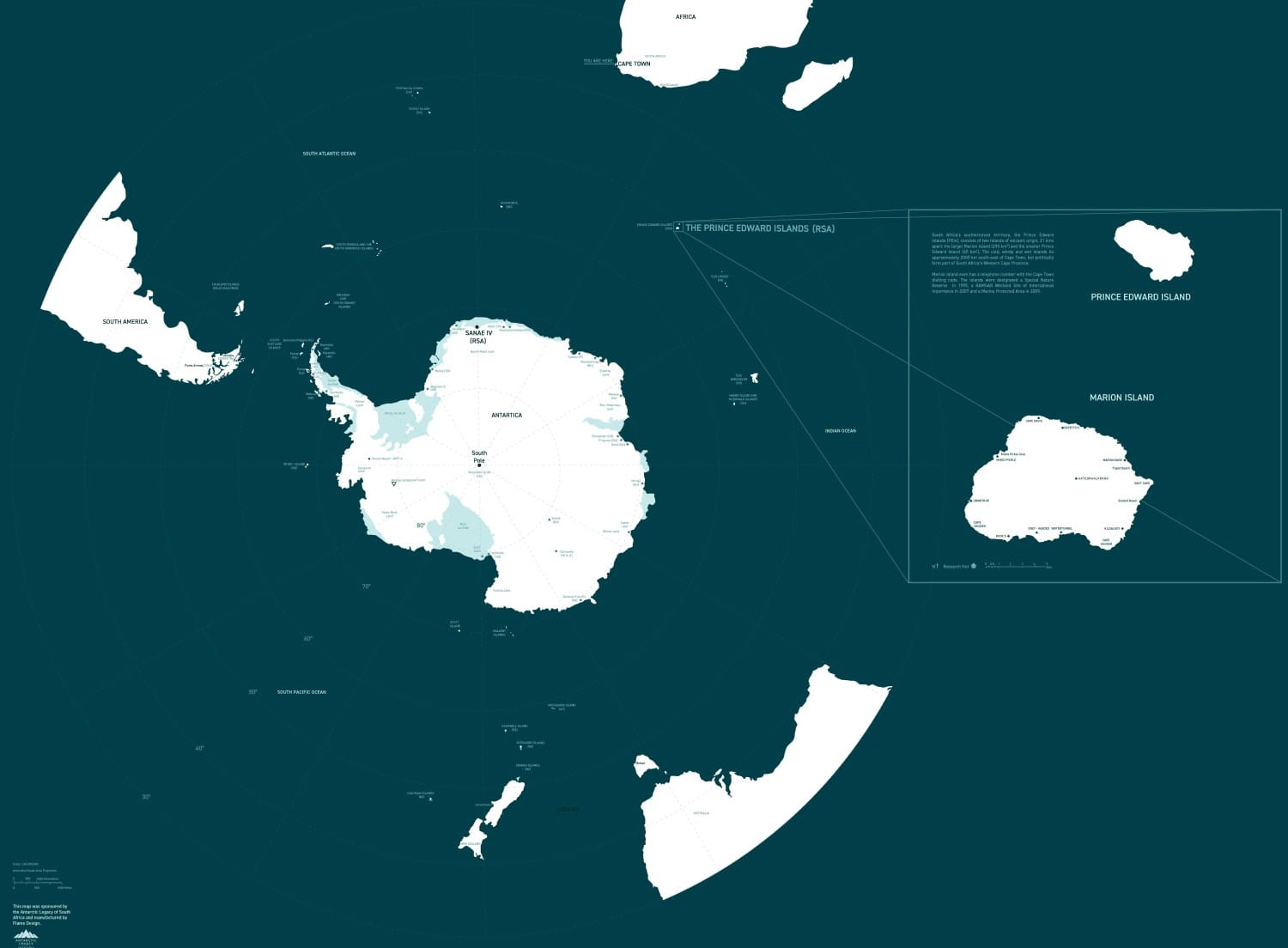 MidWinter greetings to all South Africans involved in the South African National Antarctic Programme. Especially Happy MidWinter to current and past overwintering team members. Our best wishes to all other Antarctic countries. South Africa’s Overwintering Teams send their greetings from down South.
MidWinter greetings to all South Africans involved in the South African National Antarctic Programme. Especially Happy MidWinter to current and past overwintering team members. Our best wishes to all other Antarctic countries. South Africa’s Overwintering Teams send their greetings from down South. SANAE 60 from SANAE IV on ANtarctica
SANAE 60 from SANAE IV on ANtarctica MARION 78 at Marion Island
MARION 78 at Marion Island GOUGH 66 at Gough Island
GOUGH 66 at Gough Island

 Fun and amazing facts about the albatross is that there are 22 species in the world and they can fly 16,000 km without returning to land! These seabirds are incredible and in support of World Albatross Day, ACAP have created posters and artwork of the 22 albatross species which can be downloaded at (
Fun and amazing facts about the albatross is that there are 22 species in the world and they can fly 16,000 km without returning to land! These seabirds are incredible and in support of World Albatross Day, ACAP have created posters and artwork of the 22 albatross species which can be downloaded at ( Furthermore,
Furthermore, 

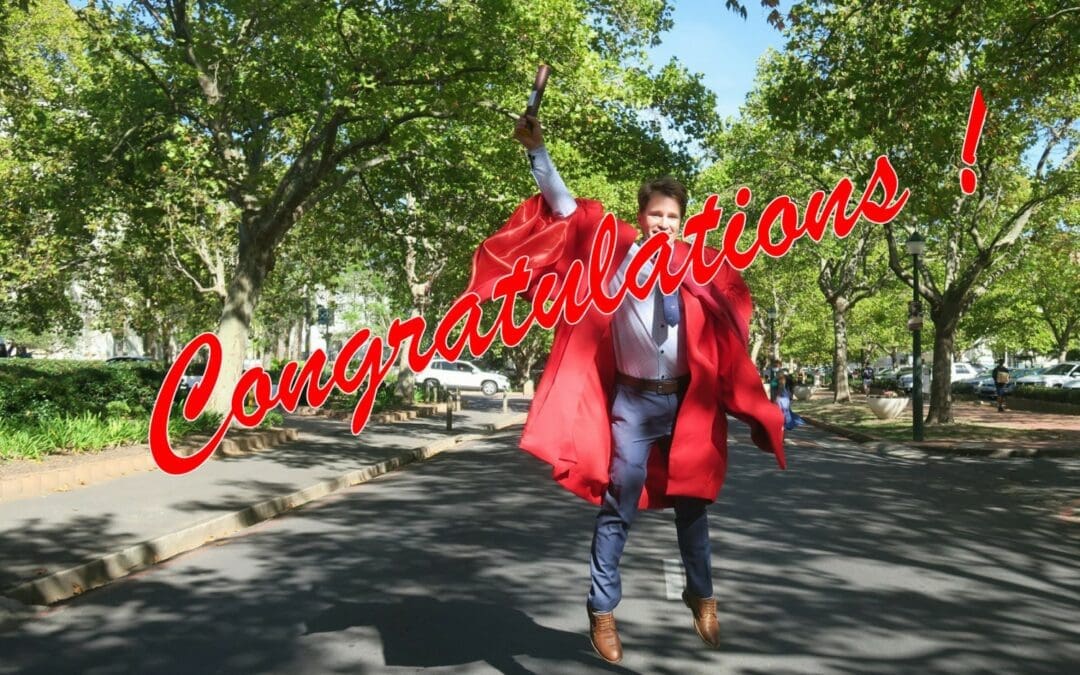
 Today 16 June 2021 on South African Youth Day we congratulate the students within SANAP community that have graduated during the past year.
Today 16 June 2021 on South African Youth Day we congratulate the students within SANAP community that have graduated during the past year.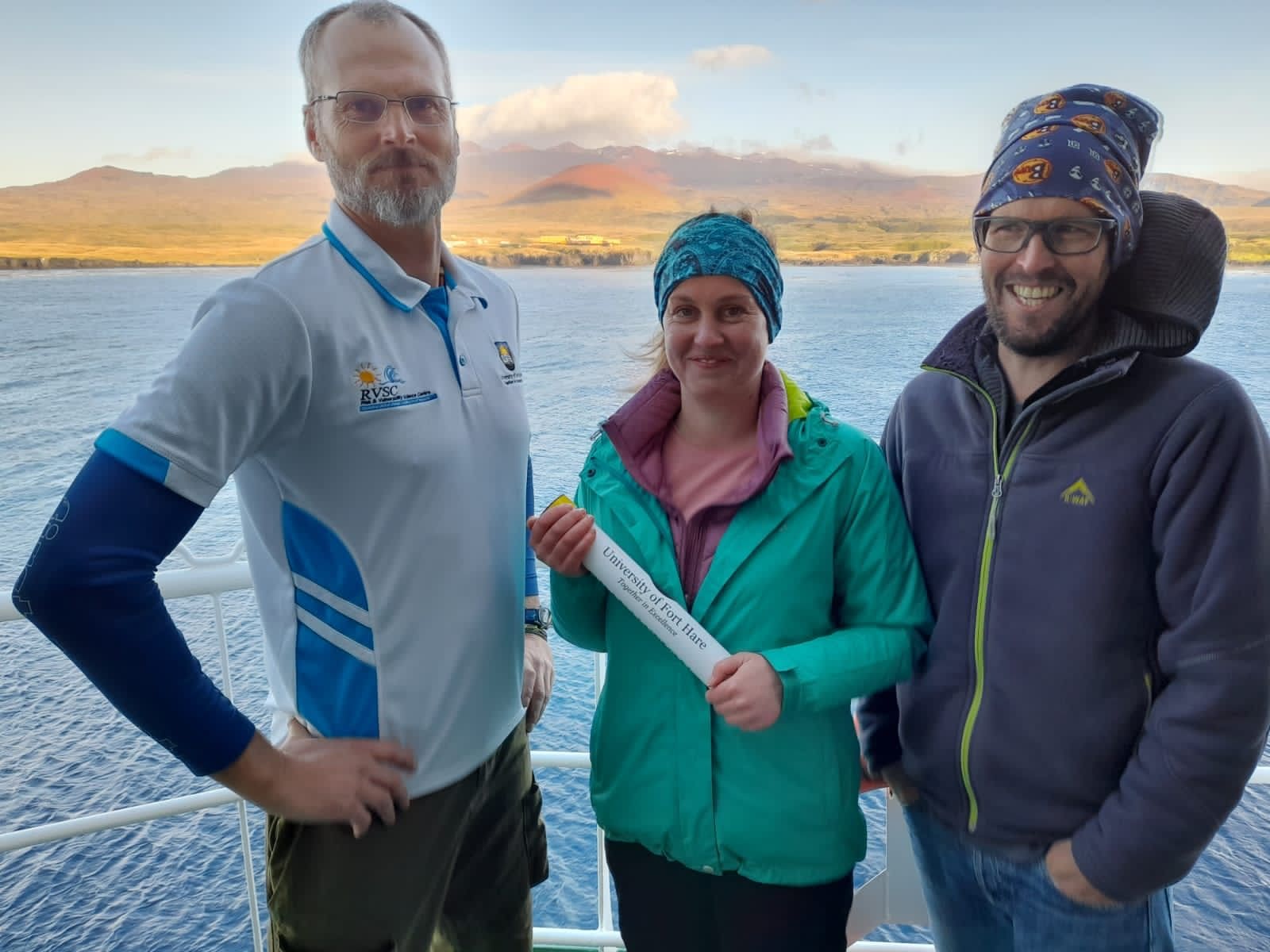
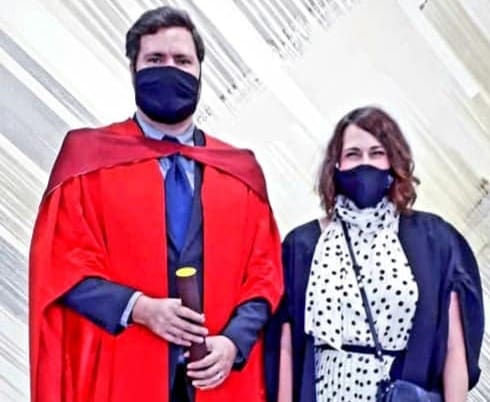 Left: Liezel Rudolph received her PhD certificate (all the way from Fort Hare University) during takeover to Marion Island on the S.A. Agulhas II with supervisors Werner Nel and David Hedding. Right: Brendon Nickerson with his supervisor Annie Bekker at PhD graduation ceremony at Stellenbosch University wearing masks.
Left: Liezel Rudolph received her PhD certificate (all the way from Fort Hare University) during takeover to Marion Island on the S.A. Agulhas II with supervisors Werner Nel and David Hedding. Right: Brendon Nickerson with his supervisor Annie Bekker at PhD graduation ceremony at Stellenbosch University wearing masks.

 The theme for this year’s United Nations World Oceans Day is “Life and Livelihood”. This theme is also in line with the declaration of intentions that launched a decade of challenges to reach the
The theme for this year’s United Nations World Oceans Day is “Life and Livelihood”. This theme is also in line with the declaration of intentions that launched a decade of challenges to reach the  needs of society. The South African ocean science community has played a key role in continuous scientific research within the Southern Ocean and Coastal regions of South Africa. This research is conducted at the South African Sub-Antarctic bases namely,
needs of society. The South African ocean science community has played a key role in continuous scientific research within the Southern Ocean and Coastal regions of South Africa. This research is conducted at the South African Sub-Antarctic bases namely, 

 Members of the Southern Ocean community set up a
Members of the Southern Ocean community set up a 

 Whether you are an early career professional or have an extensive background in polar activities, or you represent an institute, programme or initiative, your insights into how Southern Ocean science should evolve over the coming years to achieve the UN Sustainable Development Goals will provide valuable information to develop an inclusive Action Plan. If you wish to help us identify Southern Ocean priorities, we kindly ask that you read our
Whether you are an early career professional or have an extensive background in polar activities, or you represent an institute, programme or initiative, your insights into how Southern Ocean science should evolve over the coming years to achieve the UN Sustainable Development Goals will provide valuable information to develop an inclusive Action Plan. If you wish to help us identify Southern Ocean priorities, we kindly ask that you read our 
 World Environment Day 2021 will see the launch of the
World Environment Day 2021 will see the launch of the 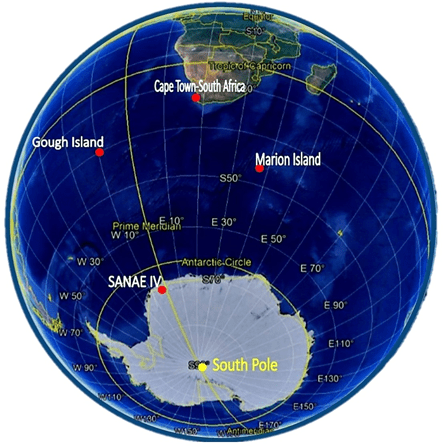
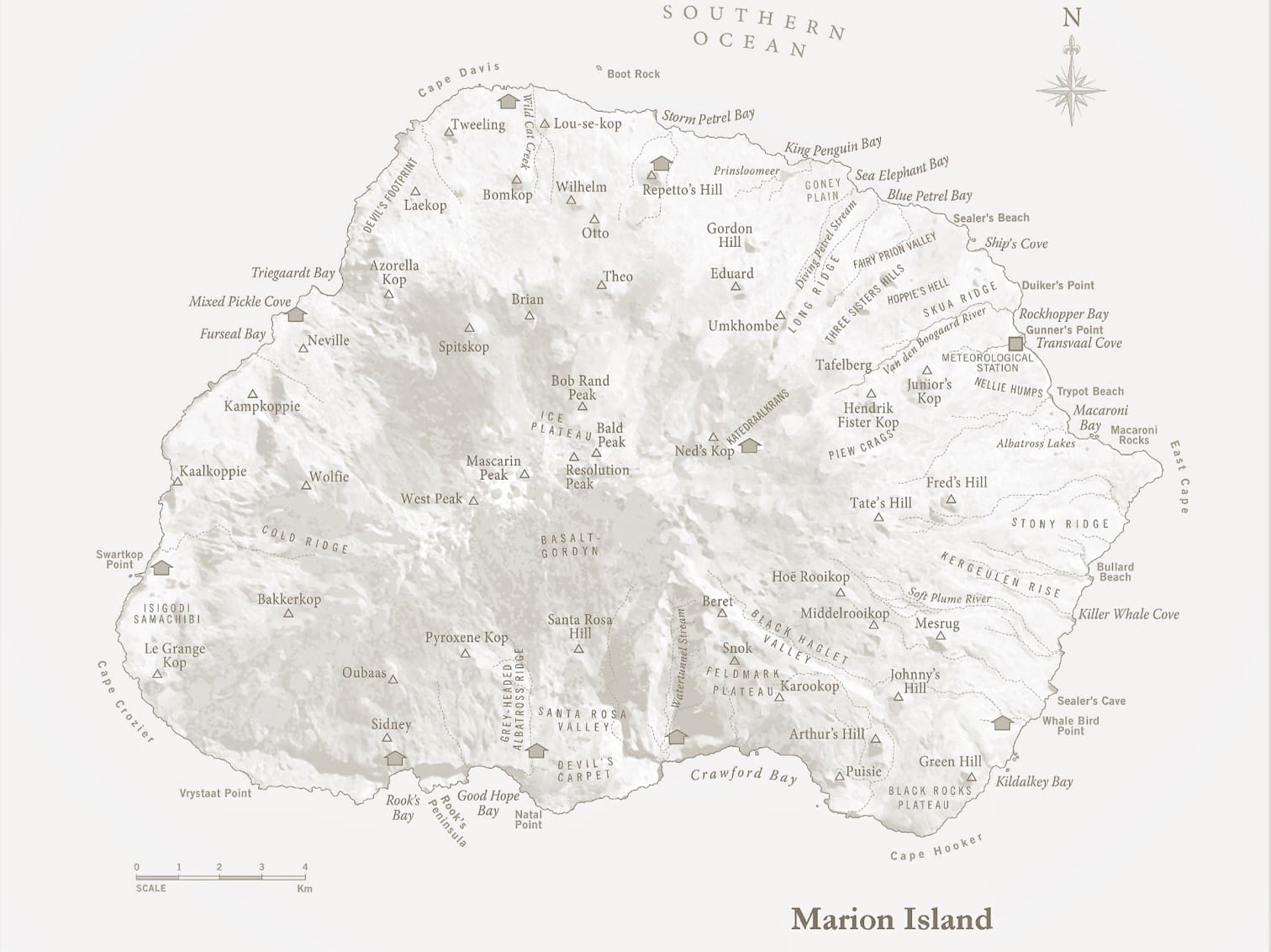
 Conservation challenges on the Prince Edward Islands (South African most southern Islands): “.. increasingly stringent conservation measures mean that the Prince Edward Islands and the surrounding oceans face far fewer conservation challenges than do most other island groups. The challenges that do remain and the natural laboratory setting that the islands provide for understanding ecological processes, give a means for researchers to assess how these challenges can be forecast, managed, and overcome. Indeed, today, the Prince Edward Islands and their surrounding oceans are largely managed for conservation and for science.” – Marion & Prince Edward Island; Africa’s Southern Islands by A Terauds, J Cooper, S Chown and P Ryan.
Conservation challenges on the Prince Edward Islands (South African most southern Islands): “.. increasingly stringent conservation measures mean that the Prince Edward Islands and the surrounding oceans face far fewer conservation challenges than do most other island groups. The challenges that do remain and the natural laboratory setting that the islands provide for understanding ecological processes, give a means for researchers to assess how these challenges can be forecast, managed, and overcome. Indeed, today, the Prince Edward Islands and their surrounding oceans are largely managed for conservation and for science.” – Marion & Prince Edward Island; Africa’s Southern Islands by A Terauds, J Cooper, S Chown and P Ryan.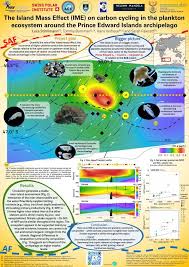 TOGETHER WE CAN BE #GENERATIONRESTORATION
TOGETHER WE CAN BE #GENERATIONRESTORATION (Images above – Tom Mcsherry, available on
(Images above – Tom Mcsherry, available on 





